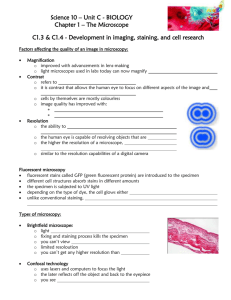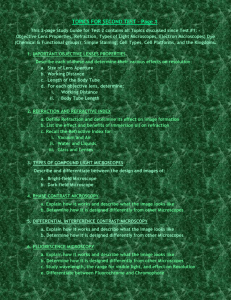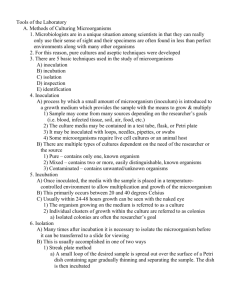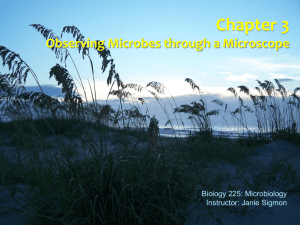Microbiology: A Systems Approach, 2nd ed.
advertisement
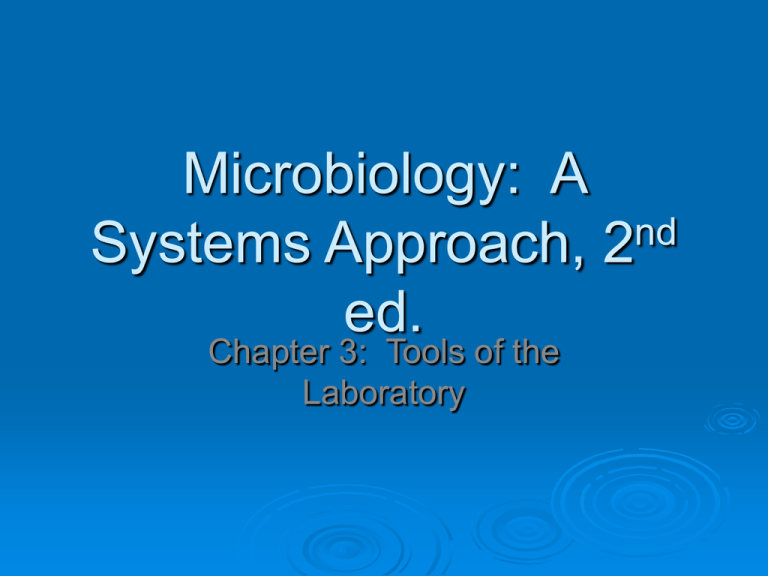
Microbiology: A nd Systems Approach, 2 ed. Chapter 3: Tools of the Laboratory 3.1 Methods of Culturing Microorganisms: The Five I’s Microbiologists use five basic techniques to manipulate, grow, examine, and characterize microorganisms in the laboratory: inoculation, incubation, isolation, inspection, and identification Figure 3.1 Inoculation and Isolation Inoculation: producing a culture Introduce a tiny sample (the inoculums) into a container of nutrient medium Isolation: separating one species from another Separating a single bacterial cell from other cells and providing it space on a nutrient surface will allow that cell to grow in to a mound of cells (a colony). If formed from a single cell, the colony contains cells from just that species. Figure 3.2 Streak Plate Method Streak plate method- small droplet of culture or sample spread over surface of the medium with an inoculating loop Figure 3.3 a,b Uses a pattern that thins out the sample and separates the cells Loop Dilation Method Loop dilation, or pour plate, method- sample inoculated serially in to a series of liquid agar tues to dilute the number of cells in each successive tubes Figure 3.3 c,d Tubes are then poured in to sterile Petri dishes and allowed to solidify Spread Plate Method • Spread plate method- small volume of liquid, diluted sample pipette on to surface of the medium and spread around evenly by a sterile spreading tool Figure 3.3 e,f Media: Providing Nutrients in the Laboratory At least 500 different types Contained in test tubes, flasks, or Petri dishes Inoculated by loops, needles, pipettes, and swabs Sterile technique necessary Classification of media Physical state Chemical composition Functional type Classification of Media by Physical State Liquid media: water-based solutions, do not solidify at temperatures above freezing, flow freely when container is tilted Semisolid media: clotlike consistency at room temperature Broths, milks, or infusions Growth seen as cloudiness or particulates Used to determine motility and to localize reactions at a specific site Solid media: a firm surface on which cells can form discrete colonies Liquefiable and nonliquefiable Useful for isolating and culturing bacteria and fungi Figure 3.4 Classification of Media by Chemical Content Synthetic media- compositions are precisely chemically defined Complex (nonsynthetic) media- if even just one component is not chemically definable Classification of Media by Function General purpose media- to grow as broad a spectrum of microbes as possible Usually nonsynthetic Contain a mixture of nutrients to support a variety of microbes Examples: nutrient agar and broth, brainheart infusion, trypticase soy agar (TSA). Enriched Media • Enriched media- contain complex organic substances (for example blood, serum, growth factors) to support the growth of fastidious bacteria. Examples: blood agar, Thayer-Martin medium (chocolate agar) Figure 3.6 Selective and Differential Media Selective media- contains one or more agents that inhibit the growth of certain microbes but not others. Example: Mannitol salt agar (MSA), MacConkey agar, Hektoen enteric (HE) agar. Differential media- allow multiple types of microorganisms to grow but display visible differences among those microorganisms. MacConkey agar can be used as a differential medium as well. Figure 3.7 Figure 3.8 Figure 3.9 Miscellaneous Media Reducing media- absorbs oxygen or slows its penetration in the medium; used for growing anaerobes or for determining oxygen requirements Carbohydrate fermentation media- contain sugars that can be fermented and a pH indicator; useful for identification of microorganisms Transport media- used to maintain and preserve specimens that need to be held for a period of time Assay media- used to test the effectiveness of antibiotics, disinfectants, antiseptics, etc. Enumeration media- used to count the numbers of organisms in a sample. Figure 3.10 Incubation Incubation: an inoculated sample is placed in an incubator to encourage growth. Usually in laboratories, between 20° and 40°C. Can control atmospheric gases as well. Can visually recognize growth as cloudiness in liquid media and colonies on solid media. Pure culture- growth of only a single known species (also called axenic) • Usually created by subculture Mixed culture- holds two or more identified species Contaminated culture- includes unwanted microorganisms of uncertain identity, or contaminants. Inspection and Identification • Inspection and identification: Using appearance as well as metabolism (biochemical tests) and sometimes genetic analysis or immunologic testing to identify the organisms in a culture. Cultures can be maintained using stock cultures Once cultures are no longer being used, they must be sterilized and destroyed properly. 3.2 The Microscope: Window on an Invisible Realm Two key characteristics of microscopes: magnification and resolving power Magnification Results when visible light waves pass through a curved lens The light experiences refraction An image is formed by the refracted light when an object is placed a certain distance from the lens and is illuminated with light The image is enlarged to a particular degree- the power of magnification Figure 3.13 Principles of Light Microscopy Magnification- occurs in two phases Objective lens- forms the real image Ocular lens- forms the virtual image Total power of magnification- the product of the power of the objective and the power of the ocular Resolution Resolution- the ability to distinguish two adjacent objects or points from one another Also known as resolving power Resolving power (RP) = Wavelength of light in nm 2 x Numerical aperture of objective lens Resolution distance= 0.61 x wavelength of light in nm Numerical aperture of objective lens Shorter wavelengths provide a better resolution Numerical aperture- describes the relative efficiency Figure 3.15 Figure 3.16 Magnification and Resolution Increased magnification decreases the resolution • Adjusting the amount of light entering the condenser using an adjustable iris diaphragm or using special dyes help increase resolution at higher magnifications Figure 3.17 Variations on the Optical Microscope Visible light microscopes- optical microscopes that use visible light. Described by their field. Four types: bright-field, dark-field, phasecontrast, and interference Other light microscopes include fluorescence microscopes and confocal microscopes Bright-Field Microscopy Most widely used Forms its image when light is transmitted through the specimen The specimen produces an image that is darker than the surrounding illuminated field Can be used with live, unstained and preserved, stain specimens Dark-Field Microscopy A bright-field microscope can be adapted to a dark-field microscope by adding a stop to the condenser The stop blocks all light from entering the objective lens except for peripheral light The specimen produces an image that is brightly illuminated against a dark field Effective for visualizing living cells that would be distorted by drying or heat or that can’t be stained with usual methods Does not allow for visualization of fine internal details of cells Phase-Contrast Microscopy Transforms subtle changes in light waves passing through a specimen into differences in light intensity Allows differentiation of internal components of live, unstained cells Useful for viewing intracellular structures such as bacterial spores, granules, and organelles Figure 3.18 Interference Microscopy Interference Microscopy Uses a differential-interference contrast (DIC) microscope Allows for detailed view of live, unstained specimens Includes two prisms that add contrasting colors to the image The image is colorful and three-dimensional Figure 3.19 Fluorescence Microscopy Includes a UV radiation source and a filter that protects the viewer’s eyes Used with dyes that show fluorescence under UV rays Forms a colored image against a black field Used in diagnosing infections caused by specific bacteria, protozoans, and viruses using fluorescent antibodies Figure 3.20 Confocal Microscopy Allows for viewing cells at higher magnifications using a laser beam of light to scan various depths in the specimen Most often used on fluorescently stained specimens Figure 3.21 Electron Microscopy Originally developed for studying nonbiological materials Biologists began using it in the early 1930s Forms an image with a beam of electrons Electrons travel in wavelike patterns 1,000 times shorter than visible light waves This increases the resolving power tremendously Magnification can be extremely high (between 5,000X and 1,000,000X for biological specimens) Allows scientists to view the finest structure of cells Two forms: transmission electron microscope (TEM) and scanning electron microscope (SEM) TEM Often used to view structures of cells and viruses Electrons are transmitted through the specimen The specimen must be very thin (20-100 nm thick) and stained to increase image contrast Dark areas of a TEM image represent thicker or denser parts Figure 3.22 SEM Creates an extremely detailed threedimensional view of all kinds of objects Electrons bombard the surface of a whole metal-coated specimen Electrons deflected from the surface are picked up by a sophisticated detector The electron pattern is displayed as an image on a television screen Contours of specimens resolved with SEM are very revealing and surprising Figure 3.23 Preparing Specimens for Optical Microscopes Generally prepared by mounting a sample on a glass slide How the slide is prepared depends on The condition of the specimen (living or preserved) The aims of the examiner (to observe overall structure, identify microorganisms, or see movement) The type of microscopy available Living Preparations Wet mounts or hanging drop mounts Wet mount: Cells suspended in fluid, a drop or two of the culture is then placed on a slide and overlaid with a cover glass Cover glass can damage larger cells and might dry or contaminate the observer’s fingers Hanging drop mount: Uses a depression slide, Vaseline, and coverslip The sample is suspended from the coverslip Figure 3.24 Fixed, Stained Smears Smear technique developed by Robert Koch Spread a thin film made from a liquid suspension of cells and air-drying it Heat the dried smear by a process called heat fixation Some cells are fixed using chemicals Staining creates contrast and allows features of the cells to stand out Applies colored chemicals to specimens Dyes become affixed to the cells through a chemical reaction Dyes are classified as basic (cationic) dyes, or acidic (anionic) dyes. Positive and Negative Staining Positive staining: the dye sticks to the specimen to give it color Negative staining: The dye does not stick to the specimen, instead settles around its boundaries, creating a silhouette. Nigrosin and India ink commonly used Heat fixation not required, so there is less shrinkage or distortion of cells Also used to accentuate the capsule surrounding certain bacteria and yeasts Simple Stains Require only a single dye Examples include malachite green, crystal violet, basic fuchsin, and safranin All cells appear the same color but can reveal shape, size, and arrangement Differential Stains Use two differently colored dyes, the primary dye and the counterstain Distinguishes between cell types or parts Examples include Gram, acid-fast, and endospore stains Gram Staining The most universal diagnostic staining technique for bacteria Differentiation of microbes as gram positive(purple) or gram negative (red) Acid-Fast Staining Important diagnostic stain Differentiates acid-fast bacteria (pink) from non-acid-fast bacteria (blue) Important in medical microbiology Endospore Stain Dye is forced by heat into resistant bodies called spores or endospores Distinguishes between the stores and the cells they come from (the vegetative cells) Significant in medical microbiology Special Stains Used to emphasize certain cell parts that aren’t revealed by conventional staining methods Examples: capsule staining, flagellar staining Figure 3.25
